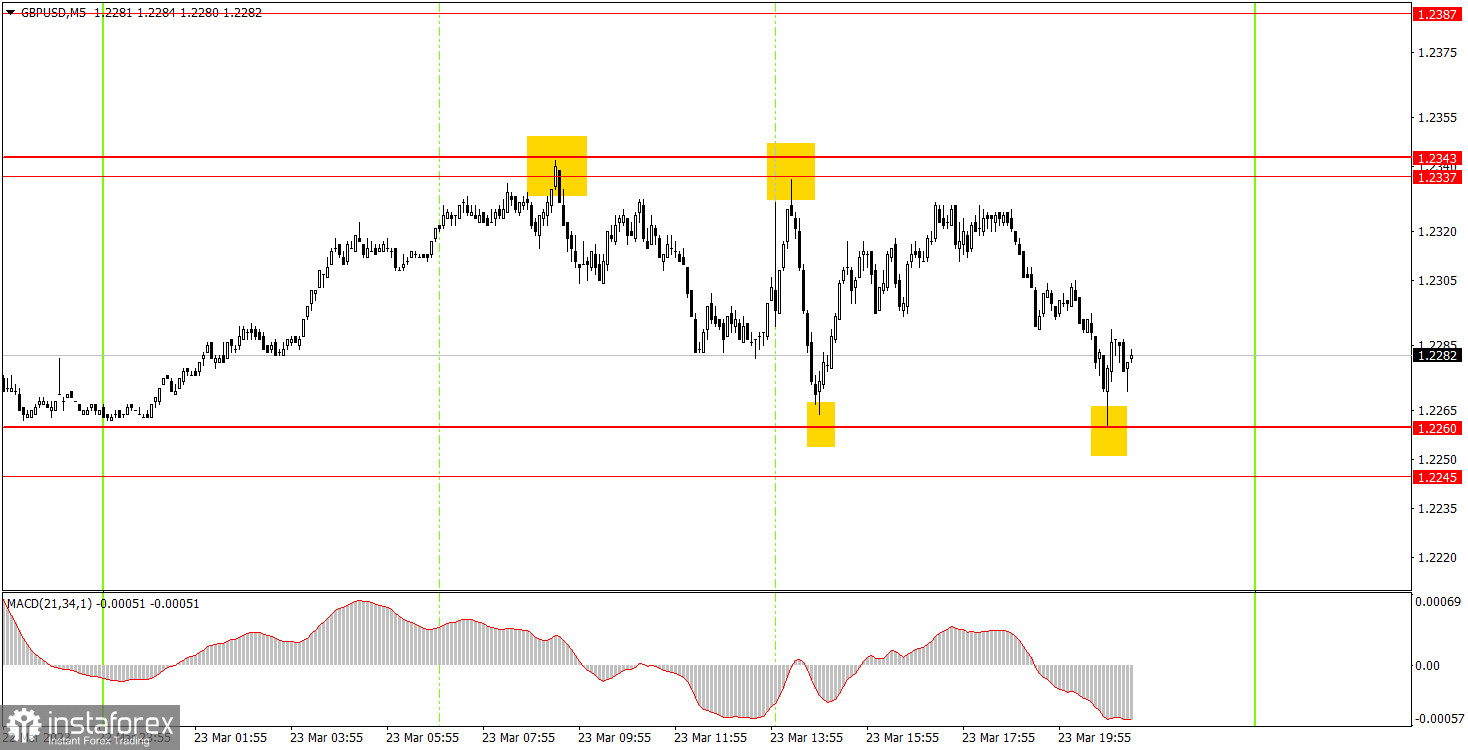Analyzing Thursday's trades:
GBP/USD on 30M chart

On Thursday, GBP/USD stopped trading higher, but did not start to correct either. The pair also failed to settle below the trend line. The whole day was spent between 1.2260 and 1.2343, i.e. in a fairly narrow price range. It is surprising, considering that the Bank of England announced the results of its meeting and on Wednesday night, the results of the Federal Reserve meeting became public. We expected a much stronger reaction. However, we already expected what decisions those central banks would make and the market probably worked them out beforehand. But even in this case, we could have counted on a counter-trend movement, which didn't happen. Just like before, I still expect the pound to fall because I don't believe there are good reasons for such a strong growth. Nevertheless, until the price settles below the trend line, it is not necessary to expect a sharp fall from the pound. The BoE raised the rate by 0.25% (which is less than in February) and did not make any important announcements.
GBP/USD on 5M chart

On the 5-minute chart, you can see how the pair moved on Thursday. It is a classic "swing" but intraday. Nevertheless, the levels that I plotted worked perfectly. There were 4 signals and almost all of them were perfectly accurate. First of all, the pair bounced from the area of 1.2337 and went down by 40 pips, but it failed to reach the target level. Thus, beginners could only place Stop Loss on Breakeven, which was used to close the short position. This was followed by another sell signal, a rebound from 1.2337, after which the pair fell to 1.2260 (with 4 pips margin of error). Beginners could gain 45 pips here, and open a long position on the rebound from 1.2260. Unfortunately, the price didn't reach the target level again, but by the evening, it was close to 1.2337. Therefore, the position should have been closed manually. The profit was another 20-25 pips.
Trading tips on Friday:
On the 30-minute chart, GBP/USD continues to move up and down or what we call a "swing" movement, but in the long term. The meetings of the Fed and the BoE did not provoke discouraging movements, the market traded relatively calmly. Now we are waiting for the bearish correction since the pair has been rising for several weeks now. On the 5-minute chart, it is recommended to trade at the levels 1.1924, 1.1992-1.2008, 1.2065-1.2079, 1.2143, 1.2171-1.2179, 1.2245-1.2260, 1.2337-1.2343, 1.2387, 1.2444-1.2471. As soon as the price passes 20 pips in the right direction, you should set a Stop Loss to breakeven. On Friday, the UK and the US will release their own respective services and manufacturing PMIs. The US will also release its Durable Goods orders report and Fed representative James Bullard will deliver a speech.
Basic rules of the trading system:
1) The strength of the signal is determined by the time it took the signal to form (a rebound or a breakout of the level). The quicker it is formed, the stronger the signal is.
2) If two or more positions were opened near a certain level based on a false signal (which did not trigger a Take Profit or test the nearest target level), then all subsequent signals at this level should be ignored.
3) When trading flat, a pair can form multiple false signals or not form them at all. In any case, it is better to stop trading at the first sign of a flat movement.
4) Trades should be opened in the period between the start of the European session and the middle of the US trading hours when all positions must be closed manually.
5) You can trade using signals from the MACD indicator on the 30-minute time frame only amid strong volatility and a clear trend that should be confirmed by a trendline or a trend channel.
6) If two levels are located too close to each other (from 5 to 15 pips), they should be considered support and resistance levels.
On the chart:
Support and Resistance levels are the levels that serve as targets when buying or selling the pair. You can place Take Profit near these levels.
Red lines are channels or trend lines that display the current trend and show in which direction it is better to trade now.
The MACD indicator (14, 22, and 3) consists of a histogram and a signal line. When they cross, this is a signal to enter the market. It is recommended to use this indicator in combination with trend patterns (channels and trendlines).
Important announcements and economic reports that can be found on the economic calendar can seriously influence the trajectory of a currency pair. Therefore, at the time of their release, we recommend trading as carefully as possible or exiting the market in order to avoid sharp price fluctuations.
Beginners on Forex should remember that not every single trade has to be profitable. The development of a clear strategy and money management is the key to success in trading over a long period of time.
 English
English 
 Русский
Русский Bahasa Indonesia
Bahasa Indonesia Bahasa Malay
Bahasa Malay ไทย
ไทย Español
Español Deutsch
Deutsch Български
Български Français
Français Tiếng Việt
Tiếng Việt 中文
中文 বাংলা
বাংলা हिन्दी
हिन्दी Čeština
Čeština Українська
Українська Română
Română

